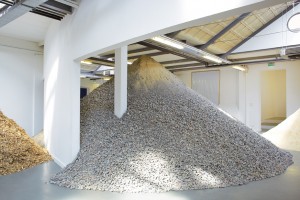« Reviews
Lara Almarcegui
TENT - Rotterdam
Lara Almarcegui: Construction Materials, Excavations, Wastelands
By Catherine Somzé
In his now famous 1997 performance Sometimes Doing Something Leads to Nothing, Belgian conceptual artist Francis Alÿs pushed an ice-block for eight hours throughout the streets of Mexico City to illustrate the impossible attempt of many of the megapolis residents to improve their living situation. Since the mid-nineties, Rotterdam-based, Spanish-born conceptual artist Lara Almarcegui has been developing a range of artistic practices that include minimal interventions in public space, book publications, performances and monumental installations. This Spring, the first major survey exhibition of Almarcegui’s work at the contemporary art centre TENT in Rotterdam reveals that the underlying coherence of Almarcegui’s varied artistic output consists in finding new ways of questioning the modernist notion of progress that might be as time-consuming, absurd, and painstaking as staging the inevitable disappearance of a melting block of ice.
Almarcegui’s exhibit, will probably catch off-guard those who are puzzled by the objectless and diverse output of conceptual artist’s practices. Barely inside the famous Rotterdam institution, one stumbles (quite literally) upon nine huge heaps of raw materials, some of which reach the ceiling of the exhibition space and take up most of the ground space as well. One can barely walk around the heaps that tower as minimalistic-looking sculptures. Almarcegui based the type and amount of material to be exhibited on a painstaking calculation of the materials that were needed to construct the central room of TENT in which they stand. This form of Land Art-inspired institutional critique has become Almarcegui’s artistic trademark over the past decade as an increasing number of mostly European art institutions have invited her to apply the concept to their own space, among which the FRAC in Dijon, the Frieze Art Fair, and most recently Secession in Vienna.
This successful combination of minimal forms, dry humour and architecture- and urbanism-related subject matters is clearly visible throughout the rest of the exhibition that showcases the various projects that have paved Almarcegui’s career since she started her residency at De Ateliers in Amsterdam almost 15 years ago. Her various series, documenting mostly ruins and wastelands, are presented as small format color photographs, dia-projections, and, more significantly perhaps, alternative tourist guides to cities such as Bilbao in Spain and São Paulo in Brazil that one can take away. Almarcegui highlights spaces and processes that, because of their fleeting nature (and seeming uselessness), go unnoticed.
Almacergui’s interest in the subversive potential of what appears useless is perhaps most clearly illustrated in the performances in which she removes the floor of art institutions and lays them back directly afterwards. The documentation of three of these performances is suitably projected close to the floor as dia-series. Throughout Almarcegui’s inventory of seemingly useless places, nonsensical actions, and bombastic yet minimal-looking sculptural gestures, she demonstrates over and over again that doing something indeed doesn’t always lead to something, and that progress goes hand-in-hand with decay. With its typical nostalgic flavor and socially engaged undertone, Almarcergui’s artistic brand of post-modern art will surely please the art aficionado looking for new intellectual adventures.
(May 6 - June 26, 2011)
Catherine Somzé is a media theory and art histoy lecturer at Willem de Kooning Academy in Rotterdam. She is the chief art critic for Time Out Amsterdam.
Filed Under: Reviews



































